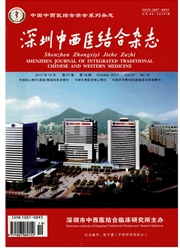

 中文摘要:
中文摘要:
目的:探讨髋关节撞击综合征(FAI)X线表现与不同中医证型的相关性,为临床疗效评价提供客观依据。方法:选择自2012年1月至2015年10月广州中医药大学附属骨伤科医院关节专科收治的髋关节撞击综合征患者120例行双髋关节正蛙位X线摄片,提取特征性X线表现,分析其与中医证型之间的联系。结果:股骨头颈交界处异常、髋臼后倾在3种中医证型间表现比较差异有统计学意义(P〈0.05),髋臼缘骨质增生及深髋臼或髋臼内突在3种中医证型间表现比较差异无统计学意义(P〉0.05)。结论:FAI中医证型与X线表现有一定的相关性,可在一定程度上作为不同中医证型的辨证参考。
 英文摘要:
英文摘要:
Objective To study the correlation between X-ray imagine and different syndrome type of traditional Chinese medicine of femoroacetabular impingement syndrome, so as to provide evidence for clinical diagnosis and treatment. Methods From Jan. 2012 to Oct. 2015, 120 patients suffered form femoroacetabular impingement syndrome from department of orthopaedics in Orthopedics hospital Affiliated to Guangzhou University of Chinese Medicine were selected and underwent bilateral hip joint projection of AP view and frog lateral view, the relationship between X-ray findings and syndrome type of traditional Chinese medicine was analyzed. Results There were significant differences among three types about the conjunction between femoral head and neck, acetabular retroversion. There were no significant differences among three types about acetabulum osteophytes, coxa profunda, protrusion acetabuli. Conclusion There is certain correlation between different syndrome type of traditional Chinese medicine of femoroacetabular impingement syndrome and X-ray findings, and it can be partly used as reference in differenting three types of TCM.
 同期刊论文项目
同期刊论文项目
 同项目期刊论文
同项目期刊论文
 期刊信息
期刊信息
